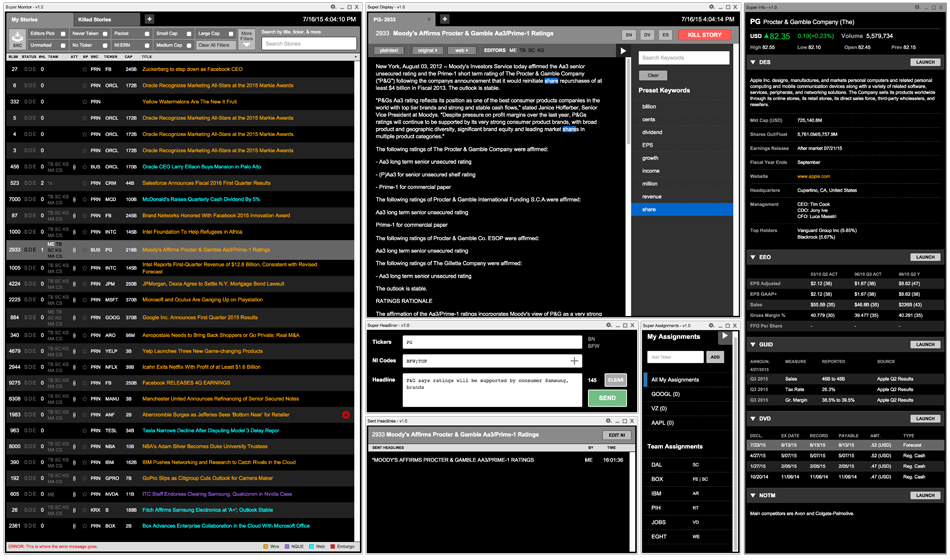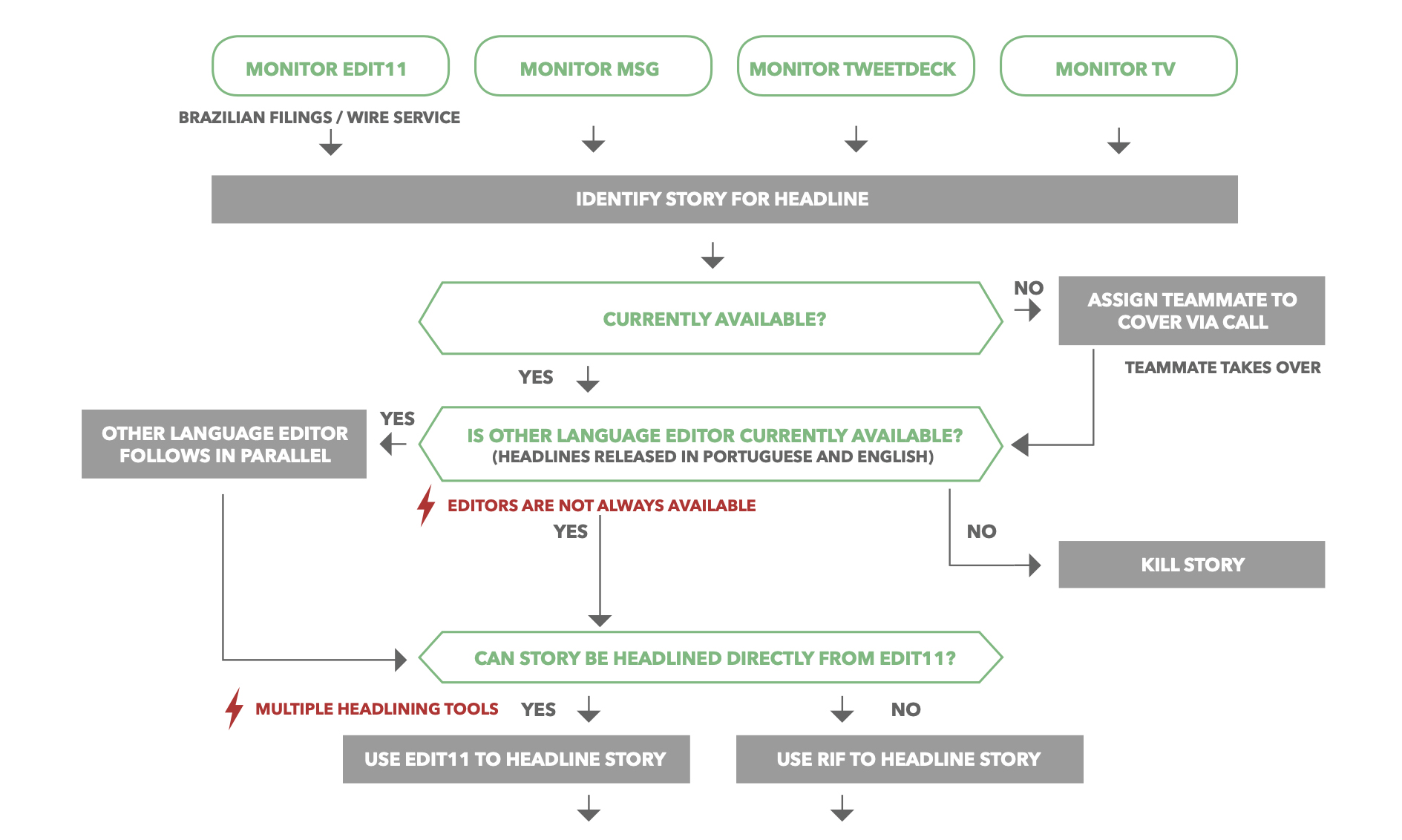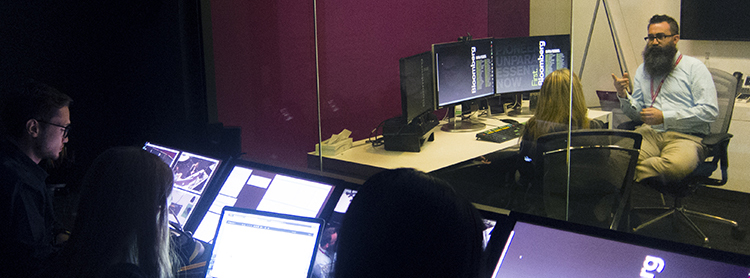Bloomberg Breaking News
overview
For the Capstone project for my Masters degree at Carnegie Mellon University I lead a team of 4 other students who collaborated with the Bloomberg Breaking News Team. Our goal was to understand the newsrooms current workflows, pointing out inefficiencies and imagining ways to evolve their tools for spotting and publishing news. Over 8-months we conducted foundational research, designed a set of interconnected modules for monitoring and publishing news, and evaluated our design decisions with combinations of paper prototyping and interactive HTML5 prototypes.
Listed below is a broad overview of our process. To dive deeper into our research process, download our research synthesis. To see the final outcome, download our design spec.
My Role
Team Lead, responsible for interaction design, visual design, and project management. Assisted with UX Research and prototyping.
Spring-Summer 2015
Publications

The Project Brief we were supplied...
The Mission Statement
To increase the efficiency and speed of Bloomberg's Breaking News coverage by evaluating the existing processes and reimagining the tools that will be used by the breaking news teams of the future.
The Background on Bloomberg
Bloomberg Professional (the Terminal) is a $20,000+ annual subscription service that provides over 300,000 subscribers with up-to-date financial data news, chat functionality, and the ability to buy and sell financial assets. Bloomberg’s software system is often paired with a proprietary keyboard which is optimized for speed. The Terminal is composed of a number of functions, which are individual applications that handle one feature, like opening up a chat window or viewing a company’s stock. The terminal is also used internally by the Breaking News team to distribute news.
The team responsible for writing and breaking news is the Bloomberg News team, which was created in 1990 to provide fast, accurate news to the financial community. At the time, the organization was 6 people, but as of early 2015, the organization has grown to over 2,400 news professionals in 73 countries producing over 5,000 stories a day. Bloomberg News strives to be the first to report news 24 hours a day, 365 days a year with complete context, perspective, and accuracy. That news is first published on the terminal to subscribers, meaning our team’s primary constraint was to work within the confines of the Terminal.
Within Bloomberg News, the Breaking News team has an important and challenging role providing users with fast and accurate market-moving financial news. Breaking News coverage is split into three teams: The Speed Desk, Bloomberg First Word, and Social Media. All teams alongside an intricate automation system share duties monitoring press wires, market data, websites, Twitter, emails, other news organizations, TV/Radio stations, teleconferences, and web events to report breaking financial news quickly and accurately. Our team was brought on to evaluate existing tools used by Breaking News and to streamline their current news monitoring and publishing workflows.
The importance of speed
Consumers of Bloomberg’s Breaking News include sales and traders, government officials, consultants, financial analysts, and a myriad of other employees in the business world. While all users of the Bloomberg Terminal care about the accuracy of breaking news, a core group of Breaking News readers care about the milliseconds in which the news is delivered. Algorithmic traders, who create formulas that make trades automatically based on the news, make up a substantive portion of this group and illustrate the fact that within the Bloomberg Breaking News world, milliseconds matter. Milliseconds are the difference between making and losing millions of dollars in a day for Bloomberg Breaking News consumers.
A high-volume,
international
news organization
Bloomberg News produces over 5,000 stories a day from more than 150 bureaus in 73 countries with more than 2400 news professionals globally. This culminated in creating workflow diagrams for five international newsrooms, bringing insight into current painpoints, how processes differed, and opportunities for improvement.
Understanding Newsroom Workflows
We spent over five months digging deep into each of the unique workflows of the various breaking news teams, to understand at a granular level each of the interactions performed on a daily basis.

A small part of one workflow from the Sao Paolo newsroom.
A Few of Our Research Methods
Domain Knowledge
To gain a fresh perspective on our project, we evaluated and compared numerous productivity tools, content creation tools, and content curation tools based on usability and features. Furthermore, we interviewed employees from organizations similar to Breaking News which deal with the curation and distribution of large amounts of data under a time constraint.
Contextual Inquiries
We immersed ourselves in the natural work environment and asked questions as work was occurring to understand our users’ tacit knowledge and uncover their underlying work structure. We conducted a total of 26 contextual inquiries over three research trips with editors, reporters, managing editors, and team leaders from the Speed Desk, Bloomberg First Word, and Bloomberg News reporters. These interviews allowed us to understand their various workflows and tools to uncover the different needs across teams.
Fly-on-the-wall observation
Due to the ongoing and intensive nature of breaking news, at times it became inappropriate for us to interrupt someone while they were working. An example of this was during the Speed Desk 4 o’clock rush when a massive amount of earning reports were released. During this time, we observed the Speed Desk and took copious amounts of notes without interrupting them.
Competitive Analysis
To draw inspiration for our design solution, we explored commercial tools with similar usage to those of the Breaking News team. We looked into 5 curation tools, 9 content creation tools, and 12 productivity tools. We created a set of usability and learnability criteria to evaluate competitors’ products in each of the categories and find what makes them effective.
Analogous Domains
In order to help inspire unique design ideas, we interviewed employees of organizations that deal with large amounts of information, learning more about the workflows and methods they use. Since we were particularly interested in those workflows which require team members to gather, manage, coordinate, and distribute large amounts of critical information in a timely manner, we specifically looked at the US Military, Urgent Care Nurses, Crowdforge (a system that uses the crowd to write individual articles), and the National Weather Service.
Newsrooms of The Future
Imagine how newsrooms will look in one year, five years, ten years, or more. To ensure our design solution is not short-lived, and to create a roadmap for implementing our design, our team looked at various technologies and trends that will shape the distribution of financial news in the future.
